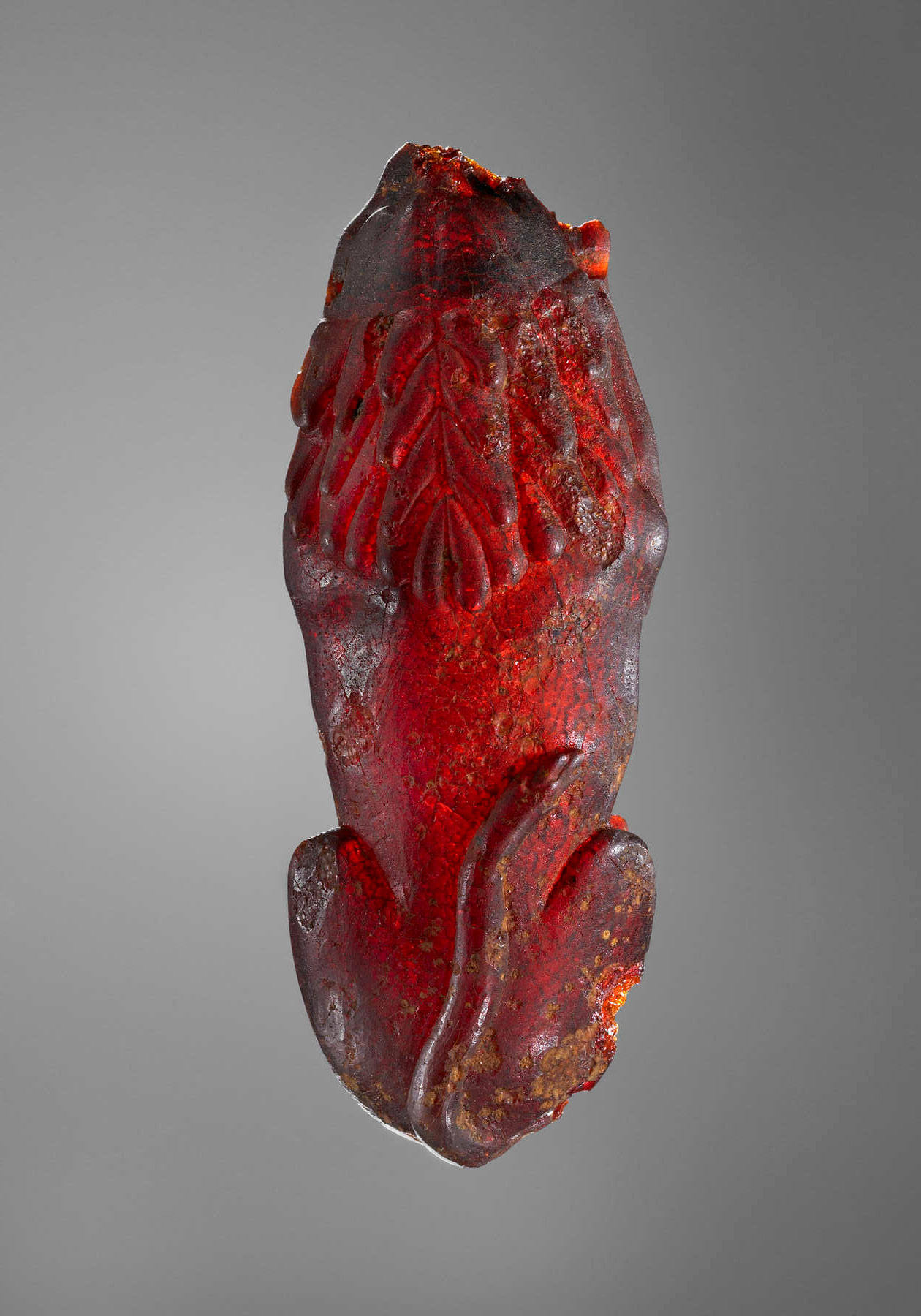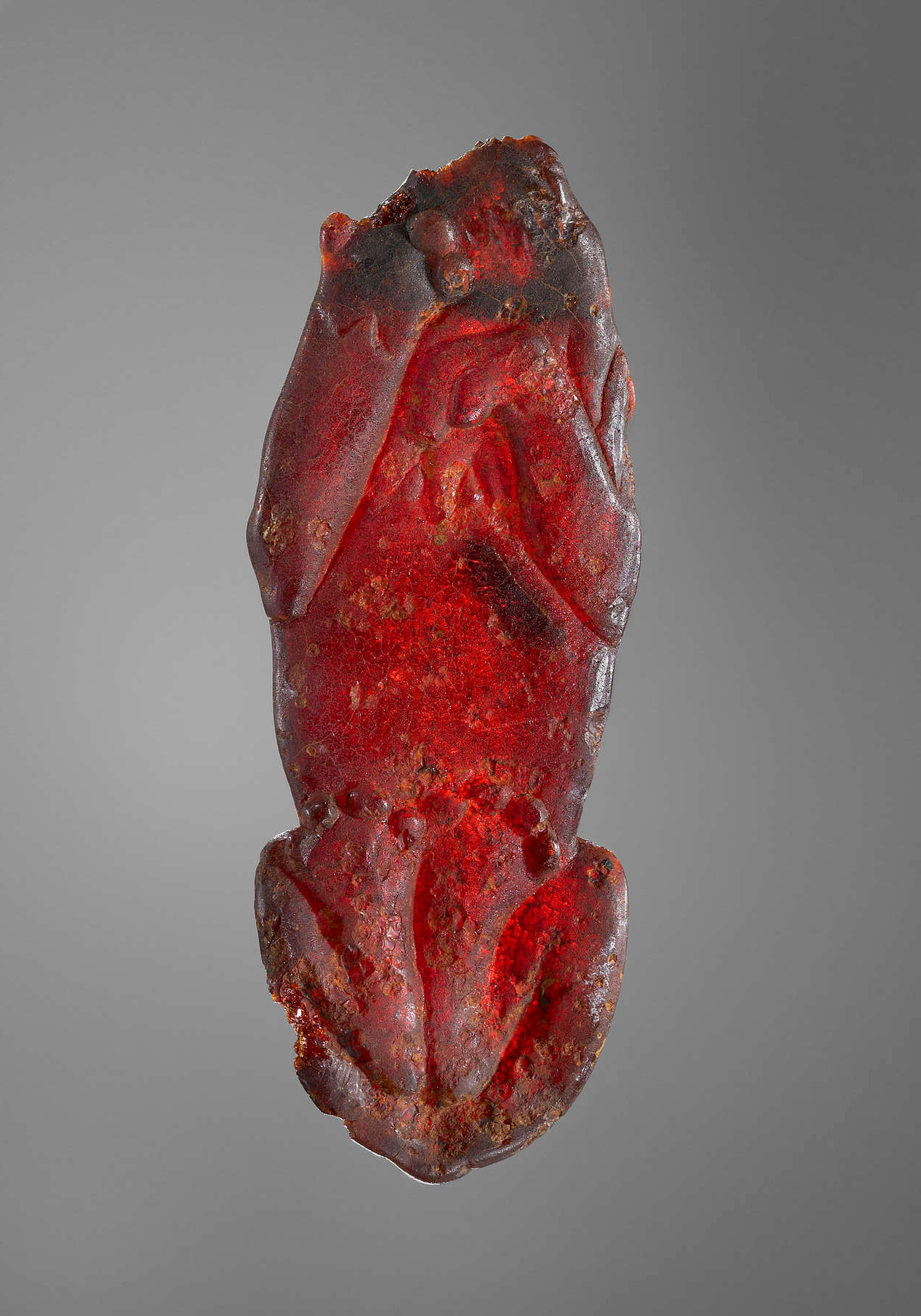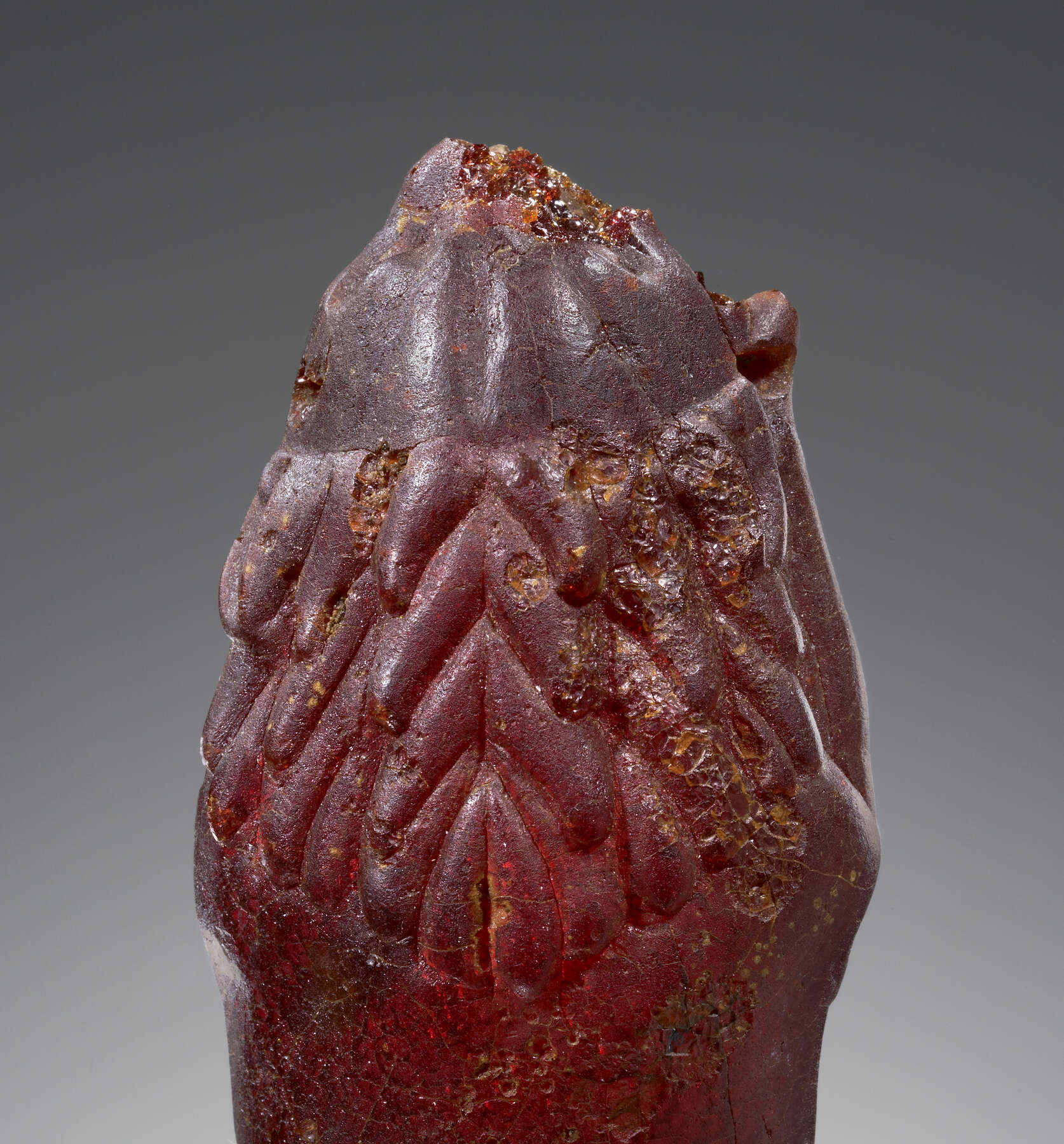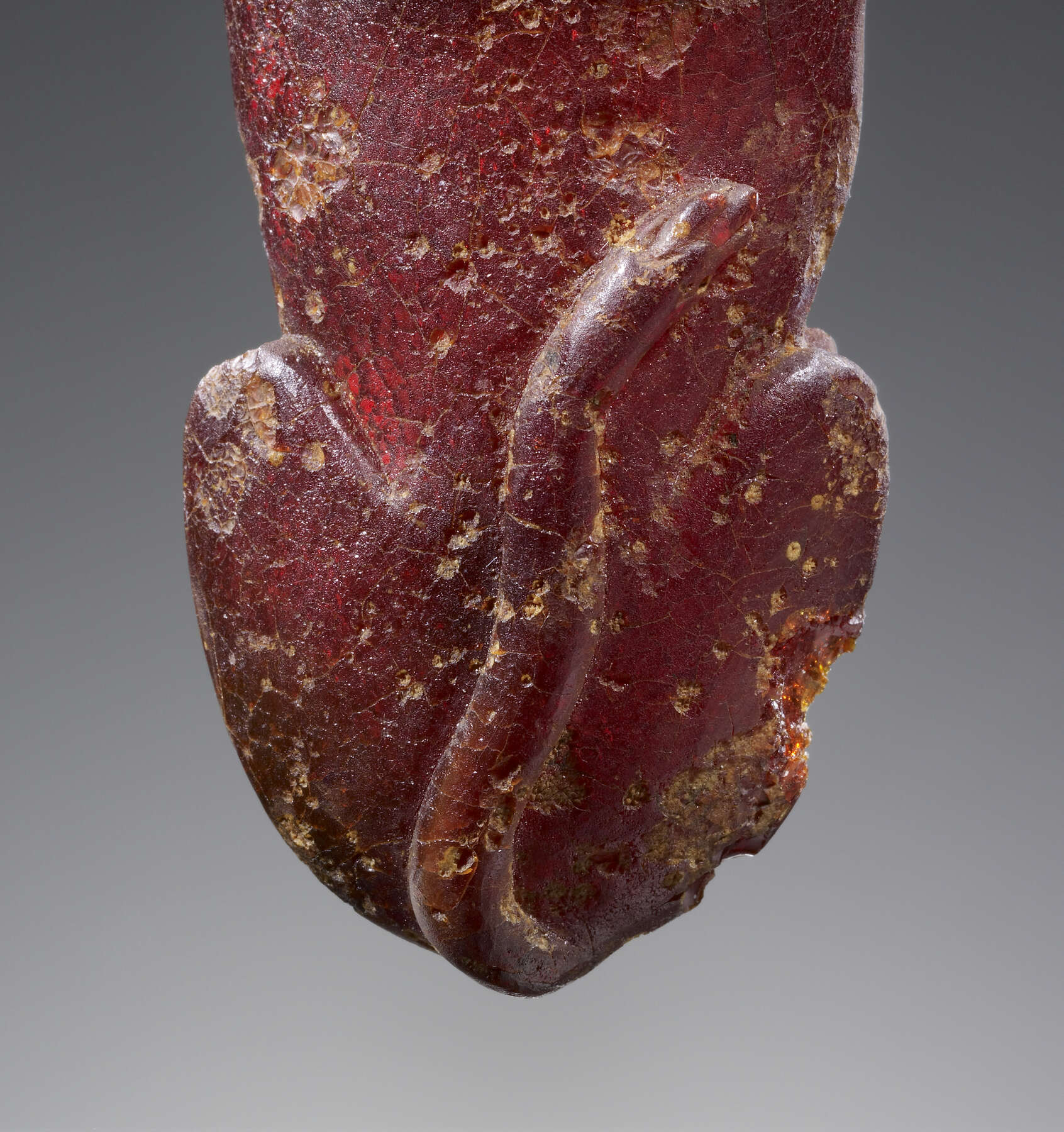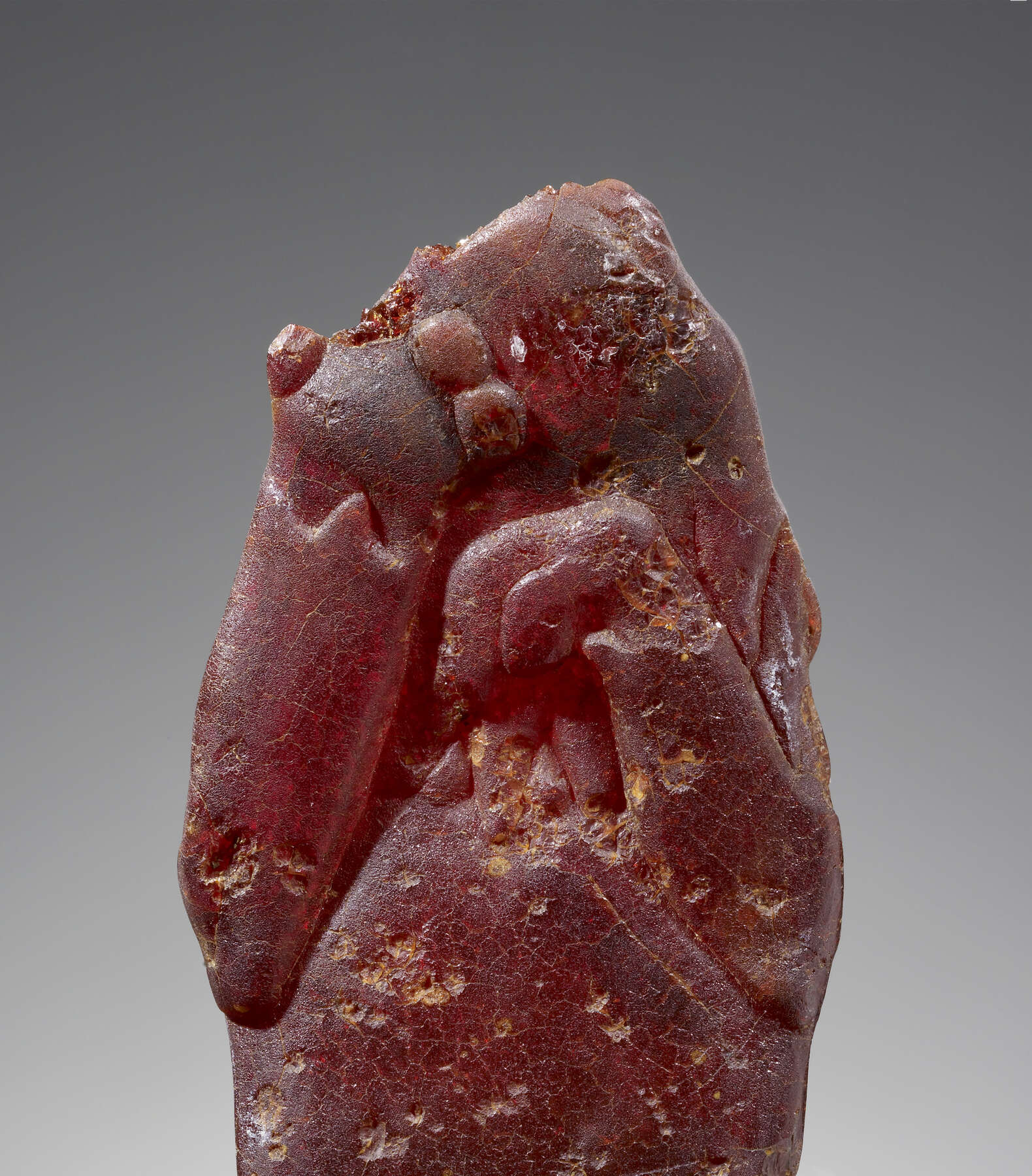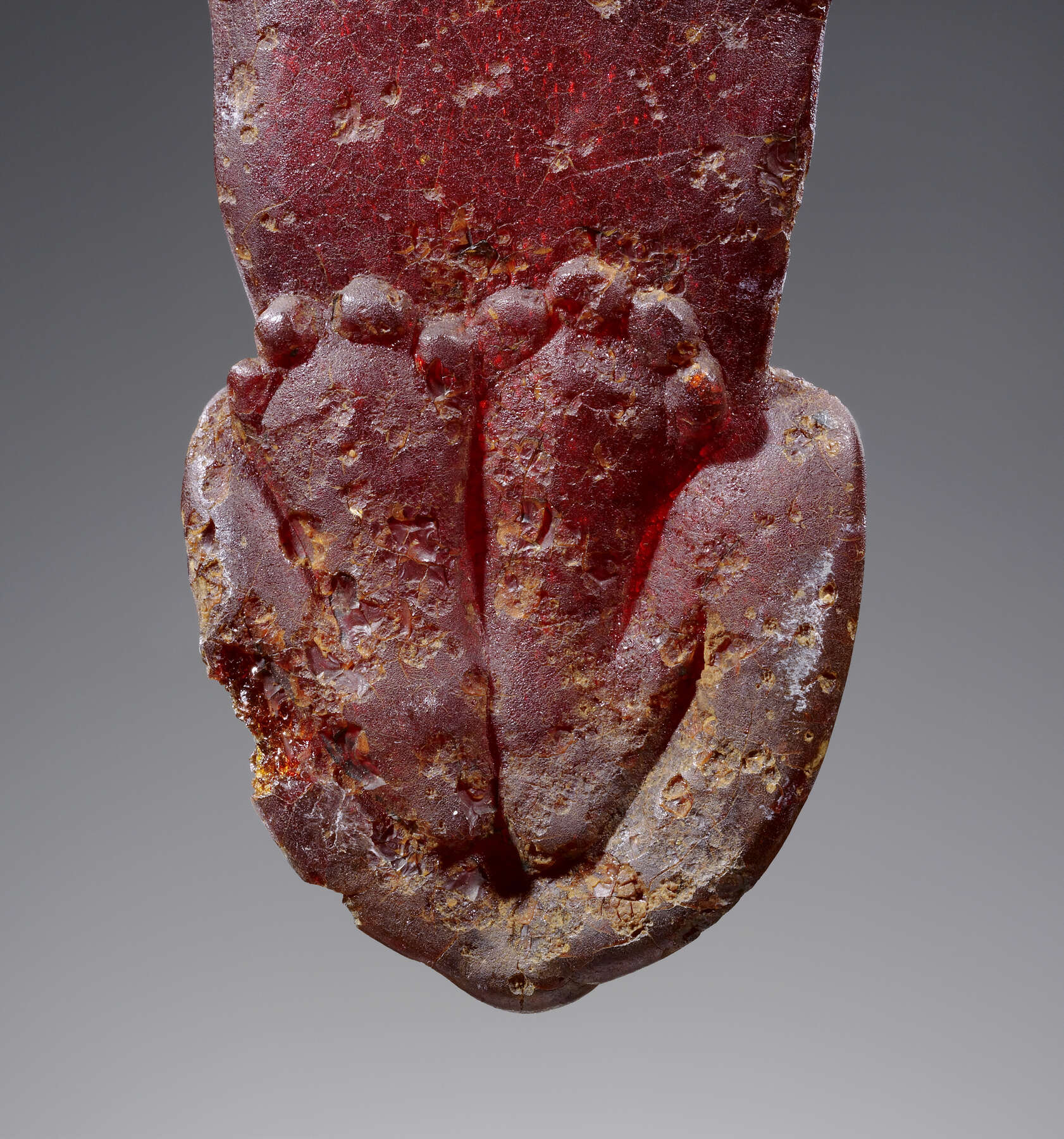31. Pendant: Lion
| Accession Number | 76.AO.78 |
| Culture | Etruscan or Campanian |
| Date | 525–480 B.C. |
| Dimensions | Length: 105 mm (as preserved; estimated original length 115 mm); width: 40 mm; depth: 18 mm (at chest); Weight: 35.5 g |
| Subjects | Egypt; Ionia, Greece (also Ionian, Greek); Lion; Transparency |
Provenance
–1976, Gordon McLendon (Dallas, TX), donated to the J. Paul Getty Museum, 1976.
Condition
The pendant is intact, with a smooth, firm surface in most areas. The tip of the nose, the right side of the animal’s muzzle, and the two distal digits of the right forepaw are broken off. There are also small breaks on the right haunch and foreleg. Small chips and pitting occur on both the dorsal and ventral surfaces and on the animal’s sides. Some of the pitted areas contain yellowish degraded material. The amber is crazed all over. Near the right shoulder blade is a large inclusion, which is also visible on the ventral surface. This piece is translucent and dull reddish brown in ambient light and pale ruby-red in transmitted light. After entry into the museum, the pendant was mechanically cleaned and then treated with an amber-oil distillate that increased the translucency and darkened the color.
Description
The lion is dorsally convex and ventrally concave, full through the upper body, with the right shoulder area thickest in volume. There is a noticeable asymmetry of form, with the body and head curving slightly toward the left and the right lower leg protruding outward. Delicate sculptural transitions in the abdomen area suggest its softness. Subtle modulations in the carving indicate the subcutaneous structure of the shoulders and back. Between the root of the tail and the hocks on the underside is a long declivity, made when the amber was being prepared for carving. The thick, tubular tail begins its curve to the left, courses right, and curves again to the left, with the tip of the tail lying on the right flank. The tip of the tail has four lobes.
The lion is positioned with all four legs drawn up under the body, the right front paw placed under the chin and the left curled up under the chest. The left foreleg is represented in side view, the outer two toes in overlapped profile, while the right front foreleg and paw are straight and the footpad flat. The right foreleg is unusual in that its dewclaw is indicated, as a modeled zigzag indentation. The hind legs draw close together against the abdomen, the haunches and legs as though in profile, the feet flattened, with all of the toe pads in a line. Each of the four feet has four large hemispherical toe pads.
The lion’s forehead has a deep medial indentation and two lateral indentations sweeping back to the mane. The almond eyes are set back, deep-set under the eyebrow ridges, which flow in a naturalistically undulating line to the wide cheekbones. Despite the losses to the top of the pendant, the nose can still be traced. Just above the break, there are two horizontal wrinkles. The muzzle, mouth, and chin are smoothly defined, with a groove for the mouth. The upper lip has two bulbous undulations on the surviving side and overlaps the lower one. The chin is short, and the throat is subtly carved to suggest the underlying anatomy. A shallow groove separates the face from the mane. The mane itself is bilaterally divided, with the median line of the forehead continued into the fur. Heavy tufts of the mane are separated into a somewhat symmetrical array. The mane hangs down onto the sides of the figure’s head and continues onto the shoulders and chest. On the ventral surface, above the left foreleg, five hanks of hair are rendered. Large, softly modeled, folded ears commence at the front edge of the mane and are tipped upward. The antihelix is represented as a raised fillet.
The curve of the lion’s body, the thinness of the pendant, the concavity of the ventral side and convexity of the dorsal, and features such as the declivity on the flank of the animal indicate the general outlines of the original shape of the amber blank. It was likely carved from an amber sheet (see introduction).
Evidence of manufacture includes the scrape marks located on the larger planes of the legs, back, and ventral surfaces. Around the eyes and in between the hanks of the mane are traces of a graver. Multidirectional abrasion marks are found near the transitions between body parts, such as the intersection of haunch and body.
The break in the muzzle offers a clear view of a triangular set of perforations for suspension: there is a cross-bore just below the top of the nose bridge and two perforations connected to an exit hole at the tip of the nose. Suspended from a filament in the cross-bore, the lion would have hung with its head uppermost, its body curving slightly downward to the right. The medial line of the lion’s mane would have been roughly perpendicular to the ground.
Discussion
76.AO.78 belongs to a large group of Archaic and Sub-Archaic ambers carved fully in the round in the shape of resting animals and demonic creatures—lions, rams, bulls, goats, gazelles, hippocamps, human-headed bulls (Achelous), sirens, and sphinxes. The compositions emphasize the dorsal and ventral sides of the animals. Their faces are flush with the ventral plane, one or both paws are beneath the chin (or lower jaw), and both pairs of legs are drawn up close to the body. The more convex side is used for the animal’s back. No two of these are alike, because in each one the animal is accommodated to the peculiarities of the amber nodule. When the pendants were new and the amber translucent, the features of one side would have been blurrily visible from the other, inviting handling so as to see the figures from every angle. The pendants would have needed to be turned over in order to see the entire animal, especially the sculptural tour de force of the curled-under paw.
Of this type of amber animal pendant, the couchant lion is the most numerous. The group includes, in addition to 76.AO.78, two pendants in Numana from a tomb at Sirolo; one from a recent find at Bologna (Tomb 12); two pendants in London, British Museum 64 and 65; one in Copenhagen; one each in private collections in Hamburg, New York, and London; and two on the art market, one in London and the other in Basel.1 A lion nearly identical to BM 65 is part of a group of a lion attacking prey, the bow decoration of a bronze fibula from Tomb 72 at Belmonte Piceno. Related in format are a pendant in the form of a feline (, cat. no. 32) and two other fibula bow decorations from Tomb 72 at Belmonte Piceno, one of a lion attacking a deer and the other in the form of a pair of addorsed lions’ heads.2
The pendant closest to 76.AO.78 is BM 64. The correlations include the overall conception of the design, the treatment of the volumes, the subtle transitions from one plane to another, and individual details such as the placement of body and limbs on the amber nodule, and the curve of the tail. Next in kin is BM 65, which is, however, less organically modeled and more simplified in key details, such as the mane and the number of toe pads (it has three each to the four of 76.AO.78), and has a flange, a bead-and-reel device, at the rump, which would have suspended the pendant head downward. These are enough alike in lion type and format that it might be hypothesized that they descend from a common sculptural invention, one close to 76.AO.78. The other lions’ heads are carved in a more schematic manner, flatter and harsher, and perhaps likely descend from a variant model or prototype.
The style of 76.AO.78 (and its closest relations) is elucidated by comparison to objects in various scales and media, but especially to large-scale marble sculpture. It is similar to a number of Archaic marble lions from the Greek East and Lydia,3 with one of the best parallels being the fragmentary marble lion’s head from Ephesus in the British Museum.4 76.AO.78 shares with these marble lions an analogous formation of the head, a comparable fine-featured, slightly pointed face, similar modeling, especially around the eyes, and most noticeably, a parallel treatment of the long mane locks. Characteristically, the manes of this group are divided into coifed hanks rendered as separate, plastically modeled lobes. In the arrangement around the head and on the back, the design varies from a full petal-like blanketing to a bifurcated overlap patterning. 76.AO.78 has in common with a complete marble lion from Miletos in Berlin and a fragmentary lion from Miletos in Paris5 an exposure of the ventral surface of the paws and the same rounded flame-shaped hanks of the mane.
The hypothetical prototype of 76.AO.78 is as likely one of amber as of ivory and was probably the work of a South Ionian artisan or someone trained in an ambient where the language and techniques of South Ionian sculpture were alive. This and the likely late-sixth-to-early-fifth-century date of 76.AO.78 argue for manufacture in the west, in Italy. So does the material: it is in these decades that large pieces of jewelry-grade amber were used for ornament-amulets found in Etruria and the areas bordering it—in the mid-Adriatic, Campania, and parts of inland South Italy. Manufacture on the west rather than the east coast of the peninsula is supported by similarity to some Campanian small bronze lions and to the lions incorporated into the top of the handles of several types of Etruscan bucchero vessels.6 The lions’ backs emerging from the surface are remarkably similar in conception.
The provenance of only the fibula lions from Tomb 72, Belmonte Piceno, is established. BM 64 and 65, from the Sir William Temple bequest, are said to have come from Armento—the same alleged provenance as that of three other stylistically related amber pendants from the Temple bequest, the “Man-headed bull-couchant (Achelous)” (BM 68), a couchant sphinx (BM 69), and a couchant gazelle (BM 70).7 In turn, this ex-Temple group is stylistically related to the large sphinx pendant from Tomb 102 at Braida di Vaglio, a burial of circa 500 B.C.8 While Belmonte Piceno, Armento (if the provenance is accurate), and Braida di Vaglio were the final resting places, they are not necessarily the places of manufacture of these ambers. In this author’s view, the carved ambers under discussion are Etruscan or Campanian, made by an artisan from South Ionia or under the strong influence of a South Ionian invention.
The tradition of small sculptures of resting animals and other creatures carved fully in the round was age-old by the sixth century B.C. Amulets in this format are documented in third-millennium Sumerian and Egyptian graves. Related to such imagery are the contorted and whirling animals, such as trussed antelopes or geese, cut into Bronze Age Aegean seals or Egyptian containers, or the ritual utensils (spoons or containers) shaped as a swimming nude woman or a running dog. Parallels among objects closer in date to 76.AO.78 and the related amber animal subjects are the amber pendants that represent sirens and other flying anthromorphs. Their antecedents are perhaps the precious metal pendants of birds and flying figures, such as the seventh-century owls from Ephesus or the bee-goddesses from Kameiros.9
However, the contemporary precious objects most like 76.AO.78 and the other amber resting animals carved fully in the round are a number of extraordinary Greek gems (dating from the late sixth century onward) of equidae in unusual poses, among them rolling and falling horses and centaurs shown in various activities.10 The horse-subject gemstones found in Cyprus, East Greece, and the Greek islands11 and the seventh-century Ephesian and Rhodian gold pendants may point to the area of origin for the sculpted “invention” behind 76.AO.78 and its relatives. It is not only the pose, the sculptural accomplishment, and the nature of the subject that link these diverse classes of objects. They also have in common a similar sculptural approach, softness in the anatomical description, minimal use of line, and smoothing of the planar transitions, all of which underline the artistic connection.
The lion of 76.AO.78 conflates many aspects of a lion’s behavior: the elongated body, lowered head, and crouching hind legs suggest that the animal is lying in wait, ready to pounce; its ears are laid back and the nose wrinkled, indications of the animal’s ferocity. Yet the closed mouth and the curled right paw belie imminent action.
Such an image may have conjured up the power of the deities of the wild, and the heroes and gods who conquered the animal. When the object was worn, the wearer may have taken on by assimilation the power of such a vanquisher. On one level, a lion amulet might have brought to its wearer the celebrated power, bravery, and ferocity of the legendary animal (probably never seen by any of the amber lion carvers). By assimilation, it may have endowed its wearers with the same qualities. A lion amulet might also incorporate danger-averting and protective functions for the owner. The lion of 76.AO.78 is vigilant, a guardian and protector, and as an amulet, it would have been powerful in both life and death. However, might the lion amber pendants also have incorporated aspects of more ancient customs? In Mesopotamia, the lion was a favorite metaphor in literature for warlike kings and fierce deities. In the Neo-Assyrian period, the lion was considered “a generally magically protective type, known as urgulû.”12
In Egypt, the lion was a symbol of the sun-god Ra, and by extension a symbol of the god Amun. As a desert dweller, the lion was believed to have regenerative capabilities and as such was an essential amulet for the dead. If the amber lion pendants incorporate Egyptian symbolism (as well as aspects of Egyptian style), what better material for them than amber, a solar substance? What better form than a tear?
At the time of their making or burial, these amber lions may have been described with the Etruscan or Italic equivalent of the Latin fulvum (English: tawny, like the hides of wild animals), which Pliny records was used to describe one kind of amber.
Two of the lion ambers indicate how they might have been worn in the grave: the Belmonte Picero lions formed the bows of bronze fibulae, and we might assume were worn on the upper part of the deceased’s body. The smaller lion in the London private collection was one of three amber pendants hanging from a hip-encircling reticulated amber girdle. In both cases, the location (and the method of attachment) could have focused the amuletic powers of the ambers. The lion pins would guard the heart and soul; the girdle pendant would protect the pelvic region. For the latter, a Late Antique prescription used in “aggressive magic” is relevant: amulets with the head of a lion were believed to have the ability to calm the womb (the roaring of the lion counteracting the “roaring” of the womb) and were to be worn in its proximity.13
Notes
- The pair in Numana, Antiquarium Statale 1548a–b, come from the sixth-century B.C. “Tomb of the Regina Picena,” Circolo 1, Fossa A, 1989 excavation, and were found with two lions’ heads: see , p. 174, nos. III.121–22; and M. Landolfi, “La tomba della Regina nella necropoli picena ‘I Pini’ di Sirolo-Numana,” in , p. 358, n. 129. Landolfi compares them to a lion on the art market illustrated in , p. 77, fig. 22. Both of the Bologna lions come from female grave contexts of the late sixth to early fifth century. The lion from the necropolis of the ex–Manifattura Tabacchi in Bologna was one of five necklace pendants from Tomb 12/2004/2005, Soprintendenza per i Beni Archeologici dell’Emilia Romagna 247773: , pp. 151–53, no. III.85. The other lion is one of eleven pendants from Tomb 11/1986 from the necropolis of the Giardini Margherita, now in Bologna (Museo Civico Archeologico SBAER240863): ibid., pp. 154–55, no. III.88. For the British Museum lions, see , pp. 75–76, 78, nos. 64–65, pl. XXV. H. Hoffman, (1969): 364, fig. 49a–b, discusses amber lions in a Hamburg private collection, in Copenhagen, and in the Norbert Schimmel Collection, New York. For the last, see also Hoffmann in , no. 72. The lions on the art market in London and Basel are unpublished. ↩
- For the fibula decorations from Tomb 72 (Ancona, Museo Archeologico Nazionale 11014 [lion and prey (perhaps a bull)], 11015 [lion attacking a deer], 11016 [addorsed lions’ heads]), see , p. 75 (as mid-Adriatic production); , p. 138 (as probably Magna Graecian); , pp. 679–80 (as mid-Adriatic); , p. 76 (as imports from southern Italy); , p. 100 (as locally made by an immigrant craftsman from Etruria [perhaps from Orvieto or Chiusi], because they served a purpose to which amber was commonly put in Picenum); and P. Marconi and L. Serra, Il Museo Nazionale delle Marche in Ancona (Ancona, 1934), p. 29. ↩
- H. Gabelmann, Studien zum Frühgriechischen Löwenbild (Berlin, 1965); ; P. Müller, Löwen und Mischwesen in der archaischen griechischen Kunst: Eine Untersuchung über ihre Bedeutung (Zurich, 1978); C. Ratté, “Five Lydian Felines,” 93 (1989): 379–93; and B. Pfeiler, “Die Silberprägung von Milet im 6. Jahrhundert v. Chr.,” Schweizerische numismatische Rundschau 45 (1966): 5–26. ↩
- British Museum B 140: , LXIII a. ↩
- Berlin, Antikensammlung Sk 2708; Louvre Ma 2790: , p. 58, no. 50 (dated end of the sixth century to beginning of the fifth century). ↩
- Compare the lions of the handles of Etruscan bucchero such as those found at Poggio Civitate: see . ↩
- The three British Museum examples are , p. 78, no. 68, pl. XXVII (“Man-headed bull-couchant [Achelous]),” no. 69, pl. XXVIII (“Sphinx couchant”), and no. 70, pl. XXVIII (“Gazelle[?] couchant”). ↩
- For Tomb 102 at Braida di Vaglio, see . ↩
- . ↩
- See E. Zweirlein-Diehl, “A Centaur Playing Kottabos,” in , pp. 397–401 (with list of examples and bibl.). ↩
- For a gray chalcedony cut horse of about 500 B.C. in a Swiss private collection, see , p. 398, no. 1027. See also Zweirlein-Diehl 2000 (in n. 10, above), p. 399. ↩
- , p. 119. ↩
- , p. 126. ↩
Bibliography
- Ambre 2007
- Ambre: Trasparenze dall’antico. Exh. cat. Naples, 2007.
- Berkin 2003
- Berkin, J. M. The Orientalizing Bucchero from the Lower Building at Poggio Civitate (Murlo). Philadelphia, 2003.
- Black and Green 1992
- Black, J., and A. Green. Gods, Demons and Symbols of Ancient Mesopotamia: An Illustrated Dictionary. Austin, TX, 1992.
- Boardman 2001
- Boardman, J. Greek Gems and Finger Rings: Early Bronze Age to Late Classical. New and enlarged ed. New York, 2001.
- Bonner 1950
- Bonner, C. Studies in Magical Amulets, Chiefly Graeco-Egyptian. Ann Arbor, 1950.
- Bottini and Setari 2003
- Bottini, A., and E. Setari. La necropoli italica di Braida di Vaglio in Basilicata: Materiali dallo scavo del 1994. With appendix by M. Torelli. 60, serie miscellanea 7. Rome, 2003.
- Brown 1960
- Brown, W. L. The Etruscan Lion. Oxford, 1960.
- Cristofani 1996
- Cristofani, M. Etruschi e altre genti nell’Italia preromana: Mobilità in età arcaica. Rome, 1996.
- Eroi e regine 2001
- Eroi e regine: Picene popolo d’Europa. Exh. cat. Rome, 2001.
- Hamiaux 1992
- Hamiaux, M. Les Sculptures grecques: Musée du Louvre. Vol. 1. Paris, 1992.
- Laffineur 1978
- Laffineur, R. L’orfèvrerie rhodienne orientalisante. Athens, 1978.
- Mastrocinque 1991
- Mastrocinque, A. L’ambra e l’Eridano: Studi sulla letteratura e sul commercio dell’ambra in età preromana. Este, 1991.
- Norbert Schimmel Collection 1974
- Muscarella, O. W. Ancient Art: The Norbert Schimmel Collection. Mainz, 1974.
- Negroni Catacchio 1989
- Negroni Catacchio, N. “L’ambra: Produzione e commerci nell’Italia preromana.” In Italia, omnium terrarum parens: La civiltà degli Enotri, Chone, Ausoni, Sanniti, Lucani, Brettii, Sicani, Siculi, Elimi, edited by C. Ampolo et al., pp. 659–96. Milan, 1989.
- Rocco 1999
- Rocco, G. Avori e ossi dal Piceno. Rome, 1999.
- Strong 1966
- Strong, D. E. Catalogue of the Carved Amber in the Department of the Greek and Roman Antiquities. London, 1966.
- Tsetskhladze et al. 2000
- Tsetskhladze, G., A. J. N. W. Prag, and A. M. Snodgrass, eds. Periplous: Papers on Classical Art and Archaeology Presented to Sir John Boardman. London, 2000.
- Tuchelt 1970
- Tuchelt, K. Die archaischen Skulpturen von Didyma: Beiträge zur frühgriechischen Plastik in Kleinasien (Istanbuler Forschungen 27). Berlin, 1970.
